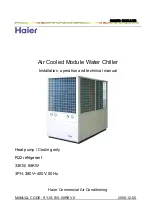
18
Fig. 17 — UPS Cover Location
Refrigerant Tracer
Carrier recommends the use of an environmentally acceptable
refrigerant tracer for leak testing with an electronic refrigerant
detector. Ultrasonic leak detectors can also be used if the chiller
is under pressure.
NOTE: If the unit is charged with refrigerant from the factory and
there is pressure on the unit, a leak check can be performed with
no other actions.
Leak Test Chiller
Due to regulations regarding refrigerant emissions and the diffi-
culties associated with separating contaminants from the refriger-
ant, Carrier recommends the following leak test procedure. Refer
to Tables 6 and 7 for refrigerant pressure/temperature values.
1. If the pressure readings are normal for the chiller condition:
a. Evacuate the charge from the vessels, if present.
b. Raise the chiller pressure, if necessary, by adding
refrigerant until pressure is at the equivalent saturated
pressure for the surrounding temperature.
c. Leak test chiller as outlined in Steps 3 to 7.
2. If the pressure readings are abnormal for the chiller condition:
a. Prepare to leak test chillers shipped with refrigerant
(Step 2h).
b. Check for large leaks by connecting a nitrogen bottle and
raising the pressure to 30 psig (207 kPa). Soap test all
joints. If the test pressure holds for 30 minutes, prepare
the test for small leaks (Steps 2g and 2h).
c. Plainly mark any leaks that are found.
d. Release the pressure in the system.
e. Repair all leaks.
f. Retest the joints that were repaired.
g. After successfully completing the test for large leaks,
remove as much nitrogen, air, and moisture as possible,
given the fact that small leaks may be present in the
system. Follow the dehydration procedure outlined in
the section “Chiller Dehydration” on page 21.
h. Slowly raise the system pressure to a maximum of
160 psig (1103 kPa) but no less than 35 psig (241 kPa)
for R-134a/R-513A by adding refrigerant (below 35 psig
refrigerant must be added as a gas). Proceed with the test
for small leaks (Steps 3 to 9).
3. Check the chiller carefully with an electronic leak detector or
soap bubble solution.
4. Leak Determination — If an electronic leak detector indicates
a leak, use a soap bubble solution, if possible, to confirm.
Total all leak rates for the entire chiller. Leakage at rates
greater than 0.1% of the total charge per year must be
repaired. Note the total chiller leak rate on the start-up report.
5. If no leak is found during the initial start-up procedures, com-
plete the transfer of refrigerant gas from the storage tank to
the chiller. Retest for leaks.
6. If no leak is found after a retest:
a. Transfer the refrigerant to the storage tank and perform a
standing vacuum test as outlined in the section “Stand-
b. If the chiller fails the standing vacuum test, check for
large leaks (Step 2b).
c. If the chiller passes the standing vacuum test, dehydrate
the chiller. Follow the procedure in the section “Chiller
Dehydration” on page 21. Charge the chiller with
refrigerant.
7. If a leak is found after a retest, pump refrigerant back into
storage tank or, if isolation valves are present, pump refrig-
erant into the non-leaking vessel. See the section See
“PUMPOUT AND REFRIGERANT TRANSFER PRO-
8. Transfer the refrigerant until the chiller pressure is at
18 in. Hg (40 kPa absolute).
9. Repair the leak and repeat the procedure, beginning from
Step 2h, to ensure a leak-tight repair. (If the chiller is opened
to the atmosphere for an extended period, evacuate it before
repeating the leak test.)
NOTE: Alternate optional leak testing method is to isolate the wa-
ter circuits and use a portable water heater to raise the temperature
of the evaporator and condenser water circuits to approximately
100°F (38°C) which corresponds to a pressure of approximately
125 psig (860 kPa).
REMOVE UPS COVER
BY PULLING IT BACK
AND CONNECT
BATTERY TERMINAL TO UPS
WARNING
Do not use air or oxygen as a means of pressurizing the chiller.
Mixtures of R-134a/R-513A and air can undergo combustion,
resulting in equipment damage and possible personal injury.
CAUTION
Never charge liquid refrigerant into the chiller if the pressure
in the chiller is less than 35 psig (241 kPa) for R-134a/R-513A
or less than 39 psig (268 kPa) for R-513A. Charge as a gas
only, with the cooler and condenser pumps running, until this
pressure is reached. Flashing of liquid refrigerant at low
pressures can cause tube freeze-up and considerable damage.
Содержание AquaEdge 19MV
Страница 49: ...49 Fig 46 SIOB...
Страница 50: ...50 Fig 47 IOB2...
Страница 51: ...51 Fig 48 19MV Auxiliary Controls Wiring...
Страница 52: ...52 Fig 49 Motor Bearing Control Board Wiring...
















































